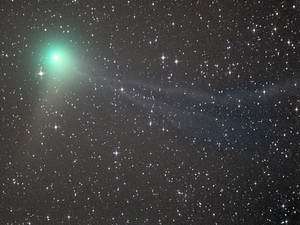A Naked Eye Comet

Throughout January, astronomers in the northern hemisphere will be watching the recently discovered Comet Macholz as it tracks across the sky. It should be visible to the unaided eye until late January and well placed in the sky for UK observers.
During January, the comet will track northward, passing through the constellations of Taurus, Perseus and Cassiopeia as it heads toward the Pole Star, Polaris. In the first few days of the new year, it should be visible about 10 degrees to the west of the bright orange star Aldebaran (the “bull’s eye” in the V-shaped star pattern of Taurus).
On the night of January 7 - 8, it will sail about 2 degrees (4 Moon widths) to the west of the easily recognisable Pleiades star cluster, often known as the Seven Sisters.
The comet was discovered by Californian amateur astronomer Don Machholz on 27 August 2004. During early January it is about 52 million km from the Earth , though the distance increases after mid-month. It will be at its closest to the Sun (about 180 million km) on 24 January. However, rather unusually, the comet spends its entire life outside the orbit of the Earth.
To find Comet Machholz, it is best to select a dark observing site away from major cities and street lights. Anyone familiar with the winter sky should look to the right of the bright constellation of Orion and then search higher in the sky for Aldebaran and the Pleiades. In binoculars, look for an object that is fuzzy compared with the much more distant stars.
Source: Royal Astronomical Society (RAS)
Image Credit: Adam Block (NOAO), AURA, NSF
















